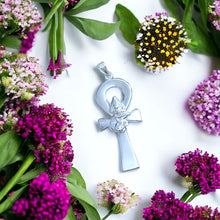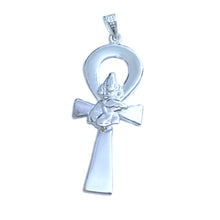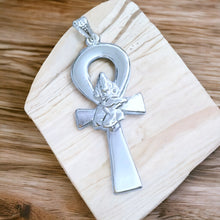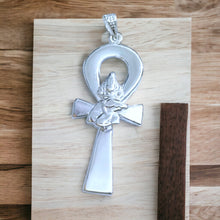
The Silver God Sobek Ankh Amulet Complex Large Pendant Necklace combines ancient Egyptian symbolism with modern elegance. Inspired by the deity Sobek, associated with protection and power, and the Ankh symbol of life, this necklace evokes a rich history of mysticism and spirituality, crafted for contemporary style.
- History: Inspired by ancient Egyptian culture, particularly the god Sobek.
- Spiritually: Represents strength, protection, and renewal, as Sobek is associated with these qualities in Egyptian mythology.
- Talisman: Believed to bring good fortune and ward off negativity.
- Handmade: Crafted with care and attention to detail, ensuring uniqueness and quality.
- Healing: Thought to promote physical and spiritual well-being, invoking the power of Sobek.
- Material Silver: Made of sterling silver, a metal associated with purity and clarity.
- Symbolism: The ankh symbolizes life, while Sobek represents strength and protection.
- How to wear: Suitable for any occasion, can be worn on a variety of chains up to 5mm in thickness.
- Ideal gift: Perfect for those interested in ancient Egyptian culture, spirituality, or seeking strength and protection.
History Side For Those Who Are Interested
The Egyptian God Sobek Ankh Amulet Complex holds a significant place in the rich tapestry of ancient Egyptian religious and cultural history. Sobek, often depicted as a crocodile-headed deity, was revered as a powerful god associated with water, fertility, protection, and military prowess. The amulet complex dedicated to Sobek Ankh symbolizes both spiritual devotion and practical beliefs in the protective powers of amulets.
The origins of Sobek worship can be traced back to the Predynastic Period (c. 5500–3100 BCE), with evidence of cultic practices emerging alongside the development of early Egyptian civilization. As settlements expanded along the Nile, Sobek's association with water became increasingly vital, as the river played a central role in sustaining life and agriculture in the region.
During the Middle Kingdom (c. 2055–1650 BCE), Sobek's prominence grew, and he became more closely linked with the pharaoh's divine authority and military prowess. Temples dedicated to Sobek flourished, particularly in the Faiyum region, where crocodiles were abundant. The city of Shedet, known in Greek as Crocodilopolis, became one of the primary centers of Sobek worship, hosting elaborate festivals and rituals in his honor.
The amulet complex dedicated to Sobek Ankh likely emerged during the New Kingdom period (c. 1550–1070 BCE), a time of significant religious and cultural innovation in ancient Egypt. Amulets were integral to Egyptian religious practice, believed to possess magical properties that could safeguard the wearer from harm and ensure prosperity in the afterlife. The Sobek Ankh amulet, featuring the god holding the ankh symbol of life, likely served as a potent talisman for protection and vitality.
As Egypt entered the Late Period (c. 664–332 BCE) and subsequently came under foreign rule, including Persian and Greek dominion, the worship of Sobek persisted albeit with some syncretism with foreign deities. The Ptolemaic rulers, in particular, promoted a fusion of Egyptian and Greek religious beliefs, leading to the emergence of new cults and variations in religious iconography.
With the rise of Christianity in Egypt following the Roman conquest, traditional Egyptian religious practices gradually declined, and many temples fell into disrepair. However, the legacy of Sobek and the amulet complex endured through the centuries, leaving an indelible mark on Egyptian religious history and cultural identity.
Today, artifacts related to Sobek, including amulets and temple inscriptions, provide valuable insights into ancient Egyptian religious beliefs and practices. The Sobek Ankh amulet complex stands as a testament to the enduring reverence for this powerful deity and the enduring legacy of ancient Egyptian civilization.











